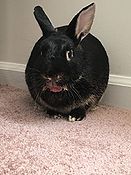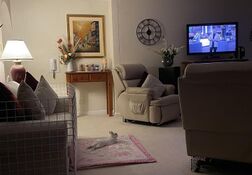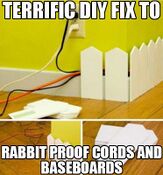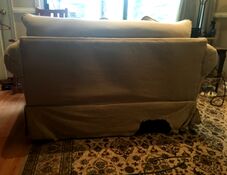Bunny-proofing
Before you allow your rabbit to roam freely in a place, make sure that the location has been bunny-proofed! This will protect the bunny from being potentially injured and protect your belongings from being irreversibly damaged. Rabbits are very curious and can get themselves into mischief that you couldn't imagine!
Some rabbits may make it incredibly difficult to properly bunny-proof walls, floors, and furniture due to their natural destructive behavior, and these bunnies may do best on a low pile rug that covers your original flooring and enclosed on it with multiple exercise pens for sufficient roaming and exercise space.
What is bunstruction?
Empowered Animals Behavior and Training, LLC posted about bunstruction:
Today, we are talking about "bunstruction." Many times, we see people who are looking for help with a "destructive" rabbit. It can help to understand the why of digging and chewing, which are super natural behaviors, when you are trying to prevent your bunny from destroying things in your home!
Rabbits use their teeth, strong feet, and claws to create tunnels, burrows, and nests. They chew roots under the ground to create clear pathways, and dig through grass to create cool places to lay. Do any of these remind you of items in your home? Items like cords and carpet? When we address unwanted chewing and digging, the FIRST thing we ask is WHERE is this happening? Often, I take a look at a bunny's home and can identify the problem spots before the human even tells me! There are certain places that will be naturally attractive to rabbits. These will be corners, dark/low-ceilinged areas (under couches/tables), and edges (where the back of the couch meets the seat, baseboards, etc.).
Rabbits often are trying to see where they can get in these places that have the makings of a good rabbit hole! When they are able to successfully pull up a carpet, dig through the fabric of a couch, or rip paint off the wall, they feel like they are making progress. They feel REALLY strongly about getting back to those areas because they were GETTING SOMEWHERE! Below are some tips to help reduce destructive behavior:
- Use large smooth tiles to cover corners, the underside of couches or tables, etc. Placing a tile that they can't bite or dig through makes sure that "progress" stops.
- Block off areas that you can't bunny-proof. Use grates (we like C&C cubes or Tespo panels) to block the underside of couches, beds, and other "cozy" spots. Ex-pens are also great chew-proof gates!
- Tie all cords together, and run them through a chew-proof PVC pipe.
Remember that your bunny is a bunny! If tried to live with a tiger, in your house, you wouldn't punish them for eating your couch-we know that a house isn't designed for a tiger! A house isn't necessarily designed for a bunny without some proofing. Use effective proofing to stop these behaviors before they start!
Chewing wires
Most rabbits will not pass up the opportunity to take a nibble or chew up a wire left unprotected in their reach. This can be dangerous if they decide to chew a live wire. Additionally, whatever cord they take a bite out of will most likely be unable to be fixed. It only takes one nibble!
There are several options available to protect your cords:
- Cover all exposed wires.
- Various types of tubing can be found in stores and online. Split-loom tubing for cars is popular and is available cheaply on Amazon.com. 1/2" is enough for most cables like ethernet and power cords. 1/4" is appropriate for cell phone chargers and other thinner cords. Other types of tubing such as vinyl can be found at hardware and home improvement stores, auto supply stores, and electronic stores. With a sharp utility knife, cut the tube length-wise and push the electrical cords inside. Tape can be used to keep the tubing stationary and connected. You can also use PVC tubing from a home improvement store as cord protectors. Please note that many wire covers only slow down the rate of chewing and give you opportunity to replace their protection before it's compromised but will not protect your wires 100%.
- If you're too lazy to buy cord covers but have old clothing lying around, you can also try threading the wires through pant or sleeve holes. The fabric will need to be tough enough to stand up to a bunny's chewing.
- If the wires must be attached to the floor or the wall, look into using floor cord protectors that can be taped.
- Keep all wires out of reach by blocking access or nailing them high off the ground. X-pens and zip-tied NIC squares work great as a fence.
- Hide wires underneath rugs or behind furniture. Be careful of hiding power cords under rugs, however, as they can pose a serious fire risk if they overheat.
- For charging cables, find armored options that are metal-wrapped. e.g. ZECEEN Metal Micro USB Cable
While you may have some success with training rabbits to ignore wires, for their full safety, all wires should be appropriately bunny-proofed. You cannot guarantee that your rabbit may not suddenly decide to change their mind and make a fatal mistake.
A live high-voltage wire can easily cause rabbits to electrocute themselves, and injuries that may result can range from burnt mouths and tongues to singed fur and whiskers.
Additionally, if the rabbit ingests the wire, especially if made from copper, it can be toxic and result in a much more serious health condition.
- puffy.y.bunny. (2022). Puffy's story of copper toxicity from chewing and eating a power cord.
- u/yzqx. (2019). Any experience with bunny electrical mouth burns?
- House Rabbit Society. (2018). Rabbit chewed a live wire and singed her teeth and fur
- u/MissiNik. (2018). Rabbit was stuck behind the bookshelf, ate sponge, wiring, carpet and skirting board trying to stay alive, and ended up with copper toxicity (Graphic)
- u/zyocuh. (2016). Rabbit broke out of cage and chewed lap wire :(




The following are some links with more information on how to protect your cords and wires.
- Miriam's Bunnies, Protecting Your Cords and Wires
- EZ Hide Wire
Digging and destroying carpet
Rabbits can dig for several reasons:
- To get to the other side of an obstruction (e.g. doors, walls)
- A scent they want to get at
- Boredom
- Unknown bunny reasons
Regardless of the reason, you will not want your rabbit to dig at or ingest the house carpet.
There are several ways to mitigate the damage.
- Toys - A bored bunny will do whatever he wants to amuse him. Providing ample toys that he likes to play with can help distract him from digging at your carpets.
- Scented deterrents. Rabbits and animals in general do not like strong scents. You may try spraying strong odors in the area to deter your rabbit from touching the carpet. Do note that your mileage may vary. See the section Repellents below for more details.
- Edible deterrents. If your rabbit chews the carpet, some rabbits will dislike the taste of bitter sprays for pets, hot pepper sauce or flakes, vinegar, or rubbed-in Ivory soap, but they can be a hit and miss. Some bunnies will not care or even love the taste.
- Covering the area. If nothing seems to work, you can cover the victim area with other materials that can easily be replaced. Some options include plastic chair mats, tile, towels, carpet scraps, blankets, mats, rugs, NIC grids, and phone books. If the item seems to be falling apart and may not protect your carpet any more, replace it. Be careful if you use towels or other fabric. Make sure your rabbit is not ingesting the fibers. One suggestion from Jennie Langdon to protect your carpet and other surfaces is CarpetSaver.
If you have not tried to mitigate the damage in the area a rabbit has chosen to dig or chew, or the rabbit ignores your mitigation tactic, be consistent on clapping your hands very loudly, shouting no, or using other methods to distract the rabbit from the carpet every time you catch him. This gives a mild negative reinforcement that digging or chewing in that location is not going to be pleasant for him. However, be sure to have appropriate chewing and digging objects nearby, and treat the rabbit for taking an interest in those instead.
Plants
There are many plants that are toxic to your bunny. The best way to keep your rabbit safe is to keep these out of reach on tables or bookshelves that are completely unable to be jumped to. You may be surprised at the places that your rabbit can reach! Remember to also take care of any falling leaves.
Additionally, you may want to keep your pretty flowers from being consumed. In this case, the same advice holds - block all access to the plant by boxing it, moving it, etc.
Furniture and walls
If a rabbit is intent on chewing baseboards, there are a few solutions:
- Place a wooden board, bumper, or dowel over favorite locations. It will block access while also giving the rabbit an acceptable alternative chewing surface.
- Rub some bitter non-toxic soap like Ivory to deter them.
- Mount some baseboard guards such with materials such as vinyl.
Also see the FAQ question "How do I encourage a rabbit to chew on toys and not unacceptable items?"


For rabbits that like to chew and tear up walls, you can block them using a variety of supplies:
- Clear wood, acrylic, or plexiglass panels from a hardware or plastic supply store. For corners, look for corner guards like this.
- Plastic or metal exercise pen or wire cube panels. See Housing for product links.
Please be especially careful allowing rabbits around walls and baseboards that may have lead-based paint. Lead poisoning is a serious concern.
- The Rabbit Sanctuary. (2022). Dasher had lead toxicity from chewing on wall skirting in an old house.
For beds and upholstery:
- Use a waterproof mattress cover around your mattress if you allow rabbits on your bed and want to prevent damage.
- Blanket throws and tarps can protect against toenails and teeth. Use a waterproof bed cover in case of accidents.
- Fence the furniture off with an exercise pen to prevent access.
 A couch is fenced off to prevent access, and more wire panels are used to bunny-proof underneath the recliner. Source: Susan Brown
A couch is fenced off to prevent access, and more wire panels are used to bunny-proof underneath the recliner. Source: Susan Brown - To prevent rabbits from running under upholstered furniture and burrowing up the soft underside, block access using cardboard or wood. You can cut or trim them to fit underneath the furniture to be invisible from a human glance. Leftover wire cubing from wire cube housing can also be used as a fence. Warning: Rabbits can die from overheating if they burrow in a sofa or bed and are unable to make their way back out. Ingested filling material can also be a serious risk and cause GI stasis.
Furniture can be moved to cover up already damaged spots and prevent further chewing.
If there is any location that you would like to deter your rabbits from, you can also try wiping some deterrents.
A multipurpose surface covering suggested by Jennie Langdon is CarpetSaver.
Other belongings
Rabbits loooooove to chew. Anything left within reach of a rabbit will most likely have some nibbles taken out of it or even suffer some digging. Keep all clothes, shoes, pillows, and other personal materials out of a rabbit's access and never leave them lying around on the floor. It would also be wise to make sure you close your closet doors to make sure a rabbit cannot jump in and wreak havoc.
Remember, it is not the rabbit's fault if items were left on the floor unattended and were consequently destroyed.
Repellents
While some people may recommend things like bitter apple spray, packaging tape, certain soaps, or spray mixtures involving vinegar, the reality is that the majority of taste/scent-based chew deterrents will not reliably stop a rabbit from chewing somewhere they want, and using them may be harmful if ingested or exposed to in large quantities.
Broadly, repellents are any odor that bunnies find repulsive and can be used in a variety of ways for bunny-proofing with mixed success. Some ideas include the following:[1]
- perfumes
- shaving lotions
- lemon oil
- fragrances
- dog and cat repellents
Smells from the garage like carburetor cleaner and motor oil can also be effective,[1] but the inhalation danger of the fumes to humans and rabbits in general make these items not recommended.
Please remember not to overdo it. Dense atomizing will keep both you and your bunnies away from the area. Be careful of rabbits actually ingesting the repellents and cease using them immediately. Do not spray them in the air as they may cause respiratory issues.
Repellents should be reapplied daily until the bunnies have lost interest in the object or area.
Blocking access
The simplest solution to all of these situations you can tell is to block complete access.
Ideas of materials to use to block your rabbit:
- zip-tied NIC panels
- exercise pen. See here for an idea on how to break apart an x-pen to use as smaller gates.
- baby gates
- plexiglass sheets
Some links to read for more information on blocking access have been listed below.
- Kathy Smith, The “Gated Community”
Repairing damage
The following are links to help you try to repair damage that your bunny has caused.
- Cindy Scheel, Home Repair Stuff Every Bunny Slave Should Have
- Cindy Scheel, Tips for Repairing Carpet Damage
- Cindy Scheel, Tips for Repairing Electrical Cords
- Cindy Scheel, Tips for Repairing Baseboard Damage
- Cindy Scheel, Tips for Repairing Sheetrock/Drywall Damage
Further reading
- Bunnyproof.com
- House Rabbit Society, FAQ: Rabbit Proofing
- OntarioRabbits.org, Hazards
- BinkyBunny.com, Bunny Proofing your Home/Yard
- San Diego House Rabbit Society. Bunny Proofing Tips and Tricks
- Kathy Smith, Bunny Proofing Revisited
- Long Island Rabbit Rescue Group, Bunny proofing your home
- About-pet-rabbits.com, Rabbit Proofing
See also
References
- ↑ 1.0 1.1 Harriman, M. (2005). House Rabbit Handbook: How to Live with an Urban Rabbit. (4th ed.).







